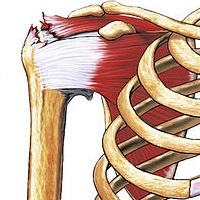
Photo from wikipedia
BACKGROUND The prevalence of subscapularis and long head of biceps (LHB) in relation to the presence and severity of posterosuperior (PS) rotator cuff disease is not known. METHODS Subjects with… Click to show full abstract
BACKGROUND The prevalence of subscapularis and long head of biceps (LHB) in relation to the presence and severity of posterosuperior (PS) rotator cuff disease is not known. METHODS Subjects with asymptomatic rotator cuff tears were enrolled for this prospective longitudinal study (n = 354) and followed annually with shoulder ultrasonography and clinical evaluations to assess for the presence of subscapularis, LHB, and PS rotator cuff pathology and pain development. RESULTS Subscapularis pathology developed in 14% of shoulders over a median follow-up of 5 years, with partial-thickness tearing occurring most commonly (83%). Age, sex, and hand dominance were not associated with subscapularis pathology. A greater proportion of concomitant full-thickness PS cuff tears were observed in shoulders that developed subscapularis tears (76% vs. 50%, P = .002). The PS cuff tear width (10 mm vs. 14 mm, P = .01) at the time of enrollment and both tear width (10 mm vs. 15 mm, P = .003) and length (12 mm vs. 15.5 mm, P = .02) at the time of diagnosis of subscapularis pathology were greater in subscapularis-torn shoulders. LHB pathology was prevalent in 34% of shoulders, with dislocation/subluxation occurring in 63% and higher prevalence in subscapularis-torn shoulders (71% vs. 12%, P < .01). Subscapularis-torn shoulders were more likely to develop pain (67% vs. 45%, P = .004), and concomitant PS cuff tear enlargement was associated with greater risk for pain development (76% vs. 36%, P = .01). CONCLUSIONS The development of subscapularis and LHB pathology is significantly related to the size of the PS cuff tear. Subscapularis involvement is associated with greater risk of pain development in degenerative rotator cuff disease.
Journal Title: Journal of shoulder and elbow surgery
Year Published: 2020
Link to full text (if available)
Share on Social Media: Sign Up to like & get
recommendations!